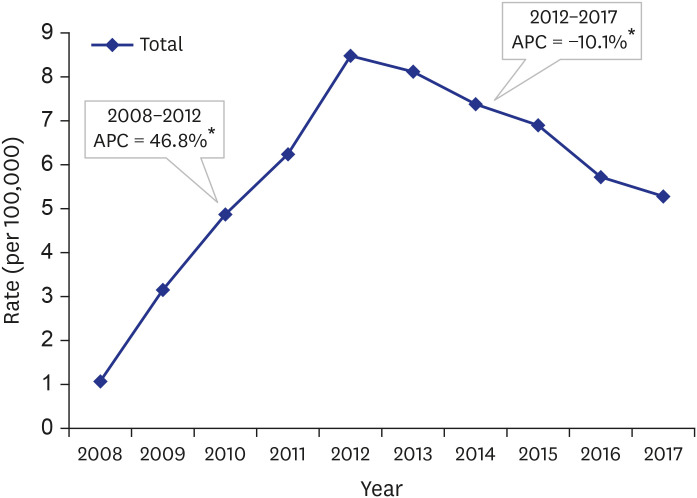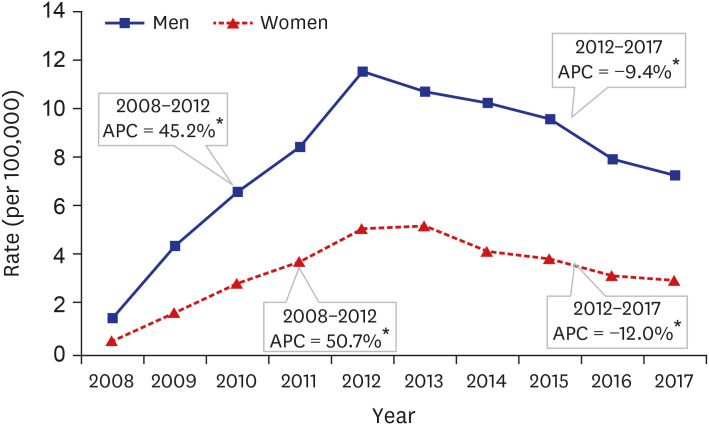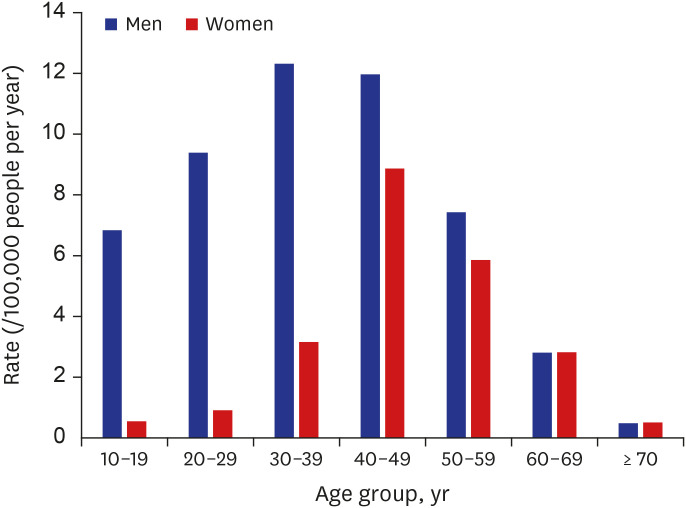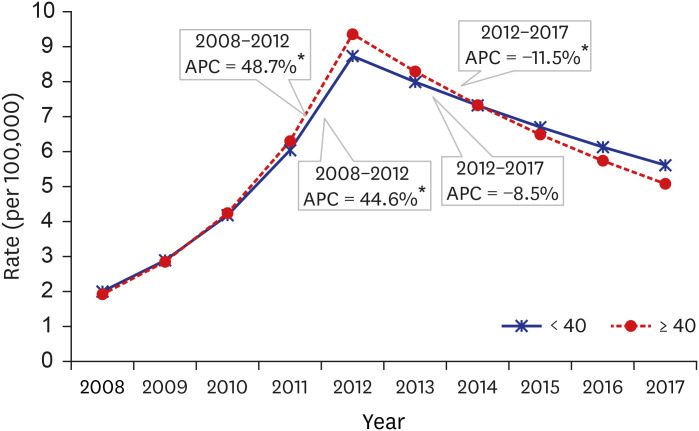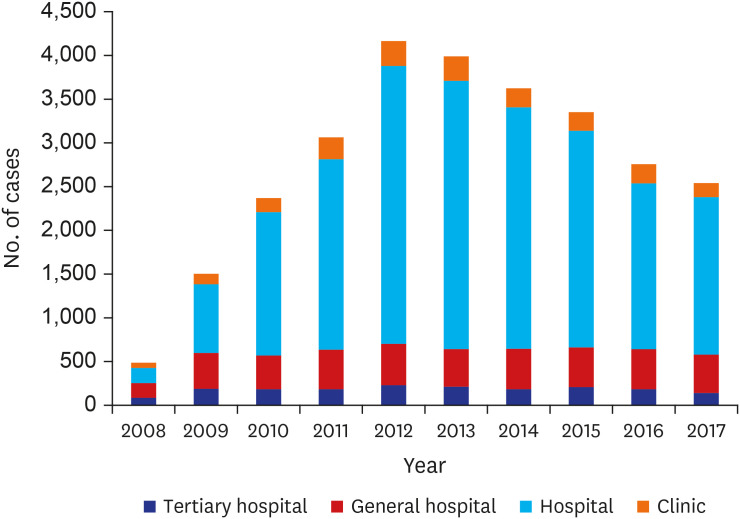J Korean Med Sci.
2020 Aug;35(34):e285. 10.3346/jkms.2020.35.e285.
National Trends in the Repair of Isolated Superior Labral Tear from Anterior to Posterior in Korea
- Affiliations
-
- 1Department of Orthopedic Surgery, Hanyang University Guri Hospital, Guri, Korea
- 2Department of Orthopedic Surgery, Base Orthopedic Clinic, Seoul, Korea
- 3Department of Orthopedic Surgery, Hanyang University College of Medicine, Seoul, Korea
- KMID: 2505722
- DOI: http://doi.org/10.3346/jkms.2020.35.e285
Abstract
- Background
The optimal treatment for superior labral tear from anterior to posterior (SLAP) lesions is controversial. Thus, we aimed to investigate the national surgical trends in isolated SLAP repair in Korea.
Methods
We analyzed a nationwide database from the Korean Health Insurance Review and Assessment Service from 2008 to 2017. We investigated the trends in SLAP repair by time, sex, age, and the type of health care institution.
Results
From 2008 to 2017, 27,850 isolated SLAP repairs were identified. Age-adjusted incidence rate of isolated SLAP repair increased by 692% from 1.07/100,000 in 2008 to 8.48/100,000 in 2012 (p = 0.005). However, the incidence rate declined significantly after 2012 (p = 0.032) and was 5.28/100,000 in 2017. Sex-specific incidence rate of isolated SLAP repair was 2.3 times higher in men than in women. The decline since 2012 was most evident in patients aged ≥ 40 years (p = 0.01); however, the incidence rates of isolated SLAP repair during the study period were similar between patients aged ≥ 40 years and those aged < 40 years. Moreover, hospitals with 30–100 beds had the greatest change in the number of isolated SLAP repair cases.
Conclusion
In Korea, the incidence of isolated SLAP repair increased dramatically until 2012; since then, it has declined. Although the decrease in isolated SLAP repair later in the study was evident in those aged ≥ 40 years, the incidence rate was still relatively high in patients aged ≥ 40 years.
Figure
Reference
-
1. Andrews JR, Carson WG Jr, McLeod WD. Glenoid labrum tears related to the long head of the biceps. Am J Sports Med. 1985; 13(5):337–341. PMID: 4051091.
Article2. Snyder SJ, Karzel RP, Del Pizzo W, Ferkel RD, Friedman MJ. SLAP lesions of the shoulder. Arthroscopy. 1990; 6(4):274–279. PMID: 2264894.
Article3. Snyder SJ, Banas MP, Karzel RP. An analysis of 140 injuries to the superior glenoid labrum. J Shoulder Elbow Surg. 1995; 4(4):243–248. PMID: 8542365.
Article4. Rhee YG, Lee DH, Lim CT. Unstable isolated SLAP lesion: clinical presentation and outcome of arthroscopic fixation. Arthroscopy. 2005; 21(9):1099. PMID: 16171635.
Article5. Kim SH, Ha KI, Kim SH, Choi HJ. Results of arthroscopic treatment of superior labral lesions. J Bone Joint Surg Am. 2002; 84(6):981–985. PMID: 12063332.
Article6. Weber SC, Martin DF, Seiler JG 3rd, Harrast JJ. Superior labrum anterior and posterior lesions of the shoulder: incidence rates, complications, and outcomes as reported by American Board of Orthopedic Surgery. Part II candidates. Am J Sports Med. 2012; 40(7):1538–1543. PMID: 22628153.7. Erickson J, Lavery K, Monica J, Gatt C, Dhawan A. Surgical treatment of symptomatic superior labrum anterior-posterior tears in patients older than 40 years: a systematic review. Am J Sports Med. 2015; 43(5):1274–1282. PMID: 24961444.8. Onyekwelu I, Khatib O, Zuckerman JD, Rokito AS, Kwon YW. The rising incidence of arthroscopic superior labrum anterior and posterior (SLAP) repairs. J Shoulder Elbow Surg. 2012; 21(6):728–731. PMID: 22608836.
Article9. Zhang AL, Kreulen C, Ngo SS, Hame SL, Wang JC, Gamradt SC. Demographic trends in arthroscopic SLAP repair in the United States. Am J Sports Med. 2012; 40(5):1144–1147. PMID: 22328710.
Article10. Cvetanovich GL, Gowd AK, Agarwalla A, Forsythe B, Romeo AA, Verma NN. Trends in the management of isolated SLAP tears in the United States. Orthop J Sports Med. 2019; 7(3):2325967119833997. PMID: 30923727.
Article11. Erickson BJ, Jain A, Abrams GD, Nicholson GP, Cole BJ, Romeo AA, et al. SLAP lesions: trends in treatment. Arthroscopy. 2016; 32(6):976–981. PMID: 26907371.
Article12. Provencher MT, McCormick F, Dewing C, McIntire S, Solomon D. A prospective analysis of 179 type 2 superior labrum anterior and posterior repairs: outcomes and factors associated with success and failure. Am J Sports Med. 2013; 41(4):880–886. PMID: 23460326.13. Nashikkar PS, Rhee SM, Desai CV, Oh JH. Is anatomical healing essential for better clinical outcome in type II SLAP repair? Clinico-radiological outcome after type II SLAP repair. Clin Orthop Surg. 2018; 10(3):358–367. PMID: 30174813.
Article14. Jo YH, Lee KH, Kim SJ, Kim J, Lee BG. National trends in surgery for rotator cuff disease in Korea. J Korean Med Sci. 2017; 32(2):357–364. PMID: 28049250.
Article15. Jo YH, Lee BG, Kim HS, Kim JH, Lee CH, Kim SJ, et al. Incidence and seasonal variation of distal radius fractures in Korea: a population-based study. J Korean Med Sci. 2018; 33(7):e48. PMID: 29359536.
Article16. Martinez-Huedo MA, Jiménez-García R, Mora-Zamorano E, Hernández-Barrera V, Villanueva-Martinez M, Lopez-de-Andres A. Trends in incidence of proximal humerus fractures, surgical procedures and outcomes among elderly hospitalized patients with and without type 2 diabetes in Spain (2001–2013). BMC Musculoskelet Disord. 2017; 18(1):522. PMID: 29228945.
Article17. Friel NA, Karas V, Slabaugh MA, Cole BJ. Outcomes of type II superior labrum, anterior to posterior (SLAP) repair: prospective evaluation at a minimum two-year follow-up. J Shoulder Elbow Surg. 2010; 19(6):859–867. PMID: 20554453.
Article18. Bencardino JT, Beltran J, Rosenberg ZS, Rokito A, Schmahmann S, Mota J, et al. Superior labrum anterior-posterior lesions: diagnosis with MR arthrography of the shoulder. Radiology. 2000; 214(1):267–271. PMID: 10644135.19. Gorantla K, Gill C, Wright RW. The outcome of type II SLAP repair: a systematic review. Arthroscopy. 2010; 26(4):537–545. PMID: 20362836.
Article20. Katz LM, Hsu S, Miller SL, Richmond JC, Khetia E, Kohli N, et al. Poor outcomes after SLAP repair: descriptive analysis and prognosis. Arthroscopy. 2009; 25(8):849–855. PMID: 19664504.
Article21. Brockmeier SF, Voos JE, Williams RJ 3rd, Altchek DW, Cordasco FA, Allen AA, et al. Outcomes after arthroscopic repair of type-II SLAP lesions. J Bone Joint Surg Am. 2009; 91(7):1595–1603. PMID: 19571081.
Article22. Boileau P, Parratte S, Chuinard C, Roussanne Y, Shia D, Bicknell R. Arthroscopic treatment of isolated type II SLAP lesions: biceps tenodesis as an alternative to reinsertion. Am J Sports Med. 2009; 37(5):929–936. PMID: 19229046.23. Edwards SL, Lee JA, Bell JE, Packer JD, Ahmad CS, Levine WN, et al. Nonoperative treatment of superior labrum anterior posterior tears: improvements in pain, function, and quality of life. Am J Sports Med. 2010; 38(7):1456–1461. PMID: 20522835.24. Shin SJ, Lee J, Jeon YS, Ko YW, Kim RG. Clinical outcomes of non-operative treatment for patients presenting SLAP lesions in diagnostic provocative tests and MR arthrography. Knee Surg Sports Traumatol Arthrosc. 2017; 25(10):3296–3302. PMID: 27342986.
Article25. Patterson BM, Creighton RA, Spang JT, Roberson JR, Kamath GV. Surgical trends in the treatment of superior labrum anterior and posterior lesions of the shoulder: analysis of data from the American Board of Orthopaedic Surgery certification examination database. Am J Sports Med. 2014; 42(8):1904–1910. PMID: 24890780.26. Neri BR, Vollmer EA, Kvitne RS. Isolated type II superior labral anterior posterior lesions: age-related outcome of arthroscopic fixation. Am J Sports Med. 2009; 37(5):937–942. PMID: 19229044.27. Alpert JM, Wuerz TH, O'Donnell TF, Carroll KM, Brucker NN, Gill TJ. The effect of age on the outcomes of arthroscopic repair of type II superior labral anterior and posterior lesions. Am J Sports Med. 2010; 38(11):2299–2303. PMID: 20739578.
Article28. Pradhan RL, Itoi E, Hatakeyama Y, Urayama M, Sato K. Superior labral strain during the throwing motion. A cadaveric study. Am J Sports Med. 2001; 29(4):488–492. PMID: 11476391.29. Yeh ML, Lintner D, Luo ZP. Stress distribution in the superior labrum during throwing motion. Am J Sports Med. 2005; 33(3):395–401. PMID: 15716255.
Article30. Franceschi F, Longo UG, Ruzzini L, Rizzello G, Maffulli N, Denaro V. No advantages in repairing a type II superior labrum anterior and posterior (SLAP) lesion when associated with rotator cuff repair in patients over age 50: a randomized controlled trial. Am J Sports Med. 2008; 36(2):247–253. PMID: 17940144.
- Full Text Links
- Actions
-
Cited
- CITED
-
- Close
- Share
- Similar articles
-
- Analysis of shoulder MR imaging using Receiver Operating Characteristic curve
- Serial Changes in Perianchor Cysts Following Arthroscopic Labral Repair Using All-Suture Anchors
- Problem Solving for Failed Superior Labrum Anterior to Posterior (SLAP) Repair
- Partial Thickness Tear of the Deep Surface of the Subscapularis Tendon: Its Relationship to the Anterior Internal Impingement
- Treatment of Acetabular Avulsion Fracture with Labral Tear Using Suture Anchor: A Case Report

